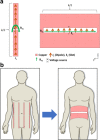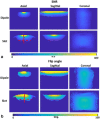Transverse slot antennas for high field MRI
- PMID: 29388250
- PMCID: PMC5985532
- DOI: 10.1002/mrm.27095
Transverse slot antennas for high field MRI
Abstract
Purpose: Introduce a novel coil design using an electrically long transversely oriented slot in a conductive sheet.
Theory and Methods: Theoretical considerations, numerical simulations, and experimental measurements are presented for transverse slot antennas as compared with electric dipole antennas.
Results: Simulations show improved central and average transmit and receive efficiency, as well as larger coverage in the transverse plane, for a single slot as compared to a single dipole element. Experiments on a body phantom confirm the simulation results for a slot antenna relative to a dipole, demonstrating a large region of relatively high sensitivity and homogeneity. Images in a human subject also show a large imaging volume for a single slot and six slot antenna array. High central transmit efficiency was observed for slot arrays relative to dipole arrays.
Conclusion: Transverse slots can exhibit improved sensitivity and larger field of view compared with traditional conductive dipoles. Simulations and experiments indicate high potential for slot antennas in high field MRI. Magn Reson Med 80:1233–1242, 2018. © 2018 The Authors Magnetic Resonance in Medicine published by Wiley Periodicals, Inc. on behalf of International Society for Magnetic Resonance in Medicine. This is an open access article under the terms of the Creative Commons Attribution NonCommercial License, which permits use, distribution and reproduction in any medium, provided the original work is properly cited and is not used for commercial purposes.
Keywords: RF antennas; coil arrays; high field MRI; slot antenna.
Figures








References
-
- Vaughan JT, Garwood M, Collins CM, et al. 7T vs. 4T: RF power, homogeneity, and signal‐to‐noise comparison in head images. Magn Reson Med 2001;46:24–30. - PubMed
-
- Hassan A, Elabyed I. Optimal geometry and capacitors distribution of 7T MRI surface coils. In Proceedings of the 40th European Microwave Conference, 2010. pp. 1437–1440.
Publication types
MeSH terms
Grants and funding
LinkOut - more resources
Full Text Sources
Other Literature Sources
Medical

